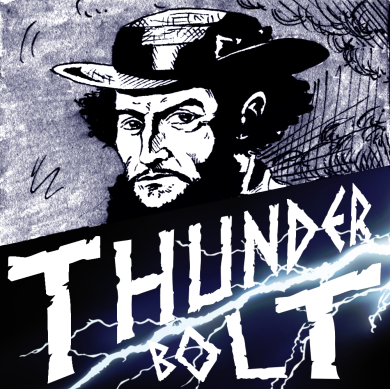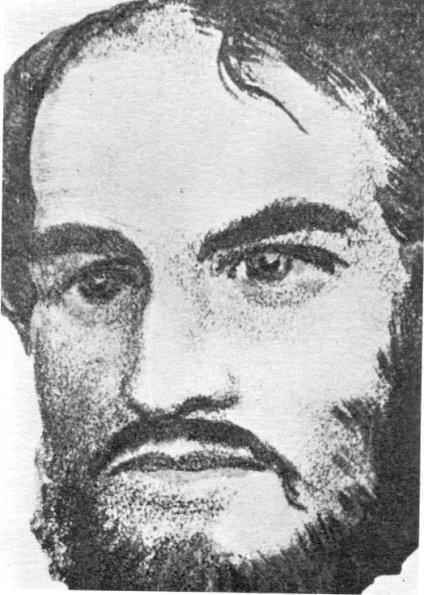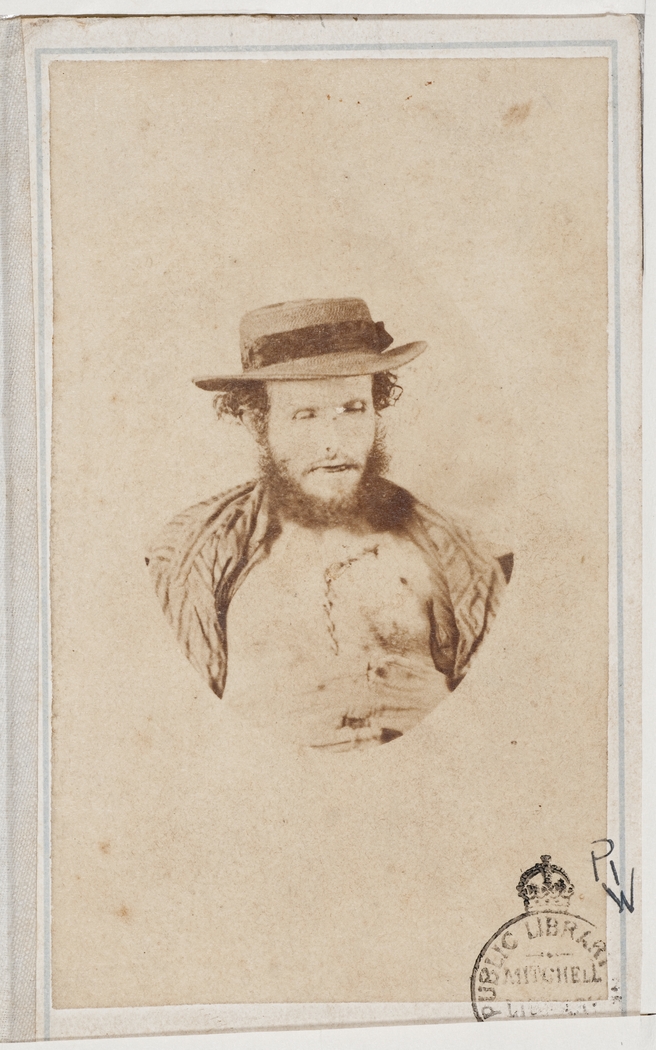
Many people have a very clear image in their head of Ned Kelly: tall, muscular, bushy beard and pompadour hairstyle. This image is Ned Kelly a day before his execution, almost six months after he was nearly shot to pieces at Glenrowan. So, if this is Ned at the end of his life how close is it to how he was in the prime of life? The truth is, even within his lifetime the idea of Ned and how he appeared was not always in line with the reality and the perception of a person can be very heavily influenced by the image we have of them. Ned’s legend has only grown since those days and the ideas of him have become so entrenched and polarising it’s time we began to try and figure out who Ned Kelly the person was. So how do we find the “real” Ned Kelly?
They say a picture says a thousand words so for this exploration we will be looking at the known images of Ned and analysing them. The earliest image of Ned is a portrait taken when he was on remand in Kyneton charged with aiding Harry Power. This image shows a gaunt looking fifteen year old in ill-fitting clothes (probably handed down from his deceased father) with a gentle wave in his hair, parted on the left demonstrating prie in his appearance. He is tight lipped and stares determinedly past the photographer almost like a challenge to some unnamed opponent. He may have been the most notorious fifteen year old of the day but nobody could have known the height of infamy this strong-bodied and hot-headed youth would reach. It was at this time that Ned was subject to an immense amount of ostracism on multiple fronts. The general public looked at him with suspicion and scorn for his criminality, many of his family and friends also looked at him with scorn because they believed he had turned Harry Power in (it was actually his Uncle Jack Lloyd who was instrumental in Harry’s capture but that’s a story for another day). So here was Ned, a teenager dealing with his own adolescence, needing to provide for his family and being treated like a black snake by all and sundry with the notable excetion of Sergeant Babington and Superintendent Nicolson who he would later write to asking for financial aide to help tide the family over. If ever there was a recipe for an angry and troubled youth this was it and Ned’s behaviour following his release from Kyneton would portray exactly this. The McCormick incident he details in his Jerilderie letter and the brawl with Senior Constable Hall demonstrate Ned to be short tempered and confrontational, traits that would land him in serious trouble.

The next image is Ned’s prison mugshot taken as he was finishing his sentence in Pentridge Prison. By the time this image was taken Ned was a hardened eighteen year old and he sports a short layer of stubble that accentuates his strong jawline. Again with pursed lips and narrowed brows this is Ned Kelly finally reaching manhood among the worst of the worst the Victorian penal system had to offer. Gone is the determined gaze of the wild fifteen year old, replaced with a hardened complicity forced into him by hard labour and enforced isolation. Incidentally there is an incredibly strong probability that during his stint here Ned crossed paths with his old teacher Harry Power and the notorious Captain Moonlite himself, Andrew Scott, who was something of a go-to guy in Pentridge for contraband (which Ned did not partake in). Ned had spent the past two plus years learning various skills including bricklaying that were to soon do him well on the outside. His time at Point Gellibrand on the Sacramento would have been his first and only time seeing any body of water greater than a river. Ned kept his head down in prison and earned himself an early remission around the time this photograph was taken. Life in Pentridge was a horror show that many fully grown men struggled to survive, let alone a seventeen year old country boy, and Ned was determined never to go back. Legend states that Ned once remarked that the next time they got him into a prison they’d have to hang him.

When Ned Kelly was released from prison he went straight – for a while. There are multiple images claiming to be Ned during this time but the only one that has been authenticated is an image that was not known to authorities of the time depicting Ned in his underwear, boxing shorts and slippers in a boxing pose which, according to the handwritten annotations on the foot of the image, was taken to commemorate his boxing match with Wild Wright. Ned looks every inch the confident young man, his features much softer in expression than the previous two images but still strong. This is the Ned of legend – tough, skilled with his hands and handsome. If only his notorious temper and personal brand of justice hadn’t toppled this path to success we may have never seen the ensuing outbreak of lawlessness that thrilled, entertained and terrified the nation for three years and cemented his place in our history.

That this image was apparently unknown to authorities in the time of Ned’s outlawry explains why it was never used to try and demonstrate his appearance. Instead, when the Kelly gang bailed up the police camp at Stringybark Creek and killed three of the troopers the police were still relying on his prison mugshot. Thereafter the police created a myriad of doctored images to try and convey Ned’s potential appearance to assist in his capture. The results range from passable to ludicrous.


Not all of the mock ups were photographic. Illustrated papers of the day took the route of rather unconvincingly adding facial hair to the known photographs of Ned in etchings to make him more closely resemble the descriptions of him, usually with the image of the bushranger as a fifteen year old as the primary source. The effect was rather akin to a child wearing a false beard to look older.




With these inaccurate depictions of Ned it’s hardly surprising that he went unrecognised for so long. In fact the lack of definitive likenesses fed into the popular media of the day with cartoonists having the flexibility to simply portray a stereotypical bearded bushranger to act as a proxy for Ned. These cartoons effectively set Ned up as the arch criminal and created a visual shorthand for unmitigated criminality that could be effectively employed against controversial political figures of the day.


When we look at the known images of Ned it tells us an awful lot about how the events of his life shaped him as well as showing where many of the ideas about Ned came from. There is one very controversial image that is supposedly Ned that has recently seen the light of day and has been nicknamed “Lumberjack Ned”. This image is of great interest to Kelly historians as this may be the only image to depict Ned and Dan Kelly together and more importantly it was a photograph owned by Ellen Kelly herself if the provenance proves to be true.

The image can be viewed at the Ned Kelly Vault in Beechworth inside a specially made box as the Kelly descendants that gave permission for the image to be exhibited had strict conditions for its display including that the image not be published in its full resolution. Many who have seen the image are split on the likelihood that the larger of these two men is in fact the most infamous outlaw in Australian history. More research needs to be undertaken and no doubt as time passes the opportunity to see this image in all its glory and make a more thorough and public analysis will eventuate. Until then we must be satisfied with the existing verified imagery. Should it prove to be legitimate it would be the most incredible image yet of Ned highlighting his imposing physique with rippling muscles in his arms, a neatly groomed beard and soft smile even showing teeth. This is a much more relatable Ned, a tradesman and pioneer who could have led a very different life under other circumstances.
Since Ned’s execution he has become a part of Australian folklore and his likeness, especially in his armour, has become an icon representing rebellion and toughness in a uniquely Australian way. This idea of Ned is closely associated with the idea of the Eureka rebels who were willing to lay down their lives in the pursuit of liberty and equality, thus Ned in his armour is often paired with the Eureka flag better known as the Southern Cross. In recent years Ned has been referred to as the “original hipster” for his unique beard and hairstyle. The idea of Ned as a rugged outdoorsman and “alpha male” accentuates the idea of Ned Kelly that appeals to the public consciousness and creates an almost aspirational figure for some who wish to possess such qualities. While this notion has taken root in Australian culture, it has very little to do with the historical Ned Kelly as we’ve seen.

Oral traditions and art helped to create a mythological Ned Kelly, which many will fight to protect while others fight to tear it down for, just as Captain Cook has become for many Australians a symbol of British colonialism and genocide while to others he represents ingenuity, determination and enlightenment, Ned Kelly is a symbol for people to focus their loves, hates, confidence and timidity on to. But what happens to the idea of this man so loved and reviled by so many when we look back on that image of the defiant, ill-kept and impoverished fifteen year old with only ten years ahead of him in his then-uncertain future? Or when we look at the photograph of the embittered eighteen year old whose rebelliousness, carelessness and anger has led him to the worst prison in Victoria? Does this entrench our ideas or elaborate on them? Will we ever reach a satisfactory and mutually acceptable understanding of the man Ned Kelly was or are we doomed to forever argue over preconceived ideas of Australia’s most notorious outlaw based on misremembered stories and popular culture? The real Ned Kelly is out there, you just need to look beyond the beard and helmet.













 This illustration from the Melbourne Punch shows the way that contemporary media would portray Ned Kelly in an attempt to cast him as a villain.
This illustration from the Melbourne Punch shows the way that contemporary media would portray Ned Kelly in an attempt to cast him as a villain.
 Within hours of the siege of Glenrowan beginning, word was reaching Melbourne and police reinforcements were being sent. On top of this people were able to get almost live updates of the proceedings thanks to the relatively new invention of telegraphs.
Within hours of the siege of Glenrowan beginning, word was reaching Melbourne and police reinforcements were being sent. On top of this people were able to get almost live updates of the proceedings thanks to the relatively new invention of telegraphs. Items such as the silk cummerbund Ned Kelly received for saving Dick Shelton from drowning help people create a connection to the Kelly story not possible with many other bushrangers.
Items such as the silk cummerbund Ned Kelly received for saving Dick Shelton from drowning help people create a connection to the Kelly story not possible with many other bushrangers. A legend in his own lifetime, Ned Kelly was just the right person to help cement Australia’s attitudes to authority and criminality in ways that impact even today.
A legend in his own lifetime, Ned Kelly was just the right person to help cement Australia’s attitudes to authority and criminality in ways that impact even today.

